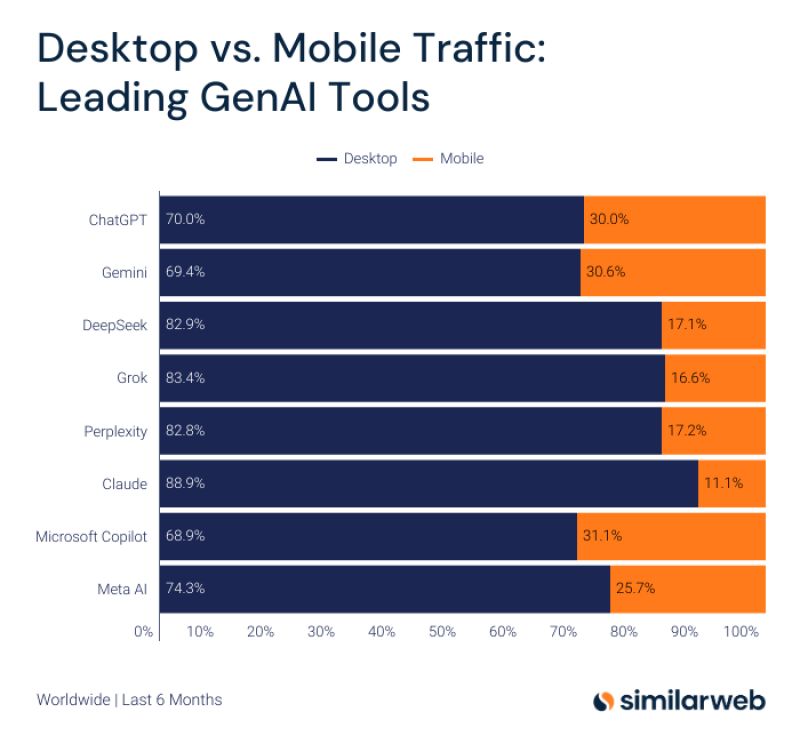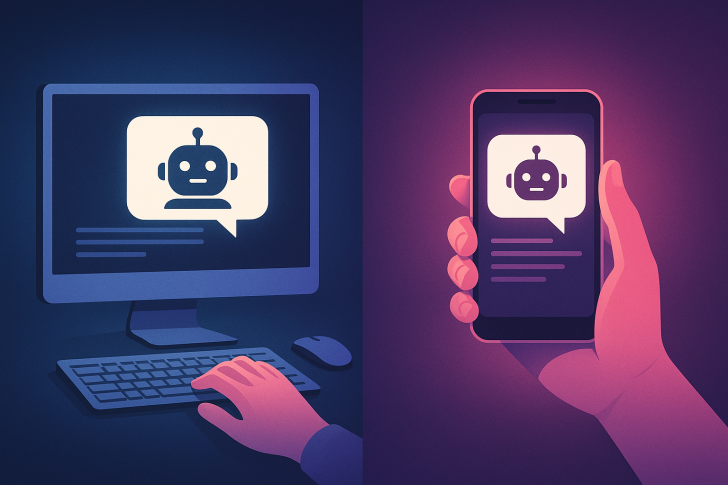As AI tools become part of everyday life, how we access them matters more than ever. New traffic data from Similarweb shows a fascinating split: some AI platforms are winning on mobile while others remain firmly rooted on desktop. This divide isn't random—it reflects who's using these tools and what they're using them for. The data covers six months of traffic across eight major platforms: ChatGPT, Gemini, DeepSeek, Grok, Perplexity, Claude, Microsoft Copilot, and Meta AI.
The Mobile Leaders
ChatGPT (30.0% mobile), Gemini (30.6% mobile), and Microsoft Copilot (31.1% mobile) lead the pack in mobile usage. These three stand out because they've cracked the code on mobile AI experiences.

While nearly 70% of their traffic still comes from desktop, their mobile share is double or triple what the desktop-focused platforms achieve. What sets them apart isn't just having a mobile app—it's how well they've adapted their entire experience for smaller screens and on-the-go usage. These platforms have:
- Strong mobile apps and responsive design
- Integration with mobile ecosystems
- Interfaces built for quick interactions
- Voice input capabilities
They're optimized for everyday scenarios—answering quick questions, helping with simple tasks, or handling searches on the go. The success of these platforms on mobile demonstrates that accessibility and user experience design matter just as much as raw model capabilities. When someone needs an answer while commuting, cooking, or away from their desk, these are the tools they reach for.
The Desktop Powerhouses
On the flip side, Claude dominates with 88.9% desktop usage, followed closely by Grok (83.4%), Perplexity (82.8%), and DeepSeek (82.9%). These tools attract users doing serious work: developers writing code, researchers diving deep into topics, analysts crunching data, and writers working on long-form content. Desktop environments offer what these tasks demand—larger screens, better keyboards, and the ability to work for extended periods without interruption.
Meta AI's Middle Ground
Meta AI sits between these extremes at 74.3% desktop and 25.7% mobile. This balance makes sense given its dual presence across Meta's mobile-heavy social platforms and its standalone web interface that many users access from desktop.
What's Behind These Patterns?
The split comes down to a few key factors. Intent drives everything—people grab their phones for quick answers but sit down at computers for real work. Platform design plays a huge role too; better mobile apps naturally attract more mobile users. The nature of the work also matters; you can ask a quick question on your phone, but try debugging code or analyzing research papers on a small screen and you'll quickly understand why developers stick to desktop. Finally, ecosystem integration shapes behavior—Copilot's Windows presence boosts desktop use while Meta AI's social platform integration drives mobile adoption.
Two Paths Forward
The data reveals an AI landscape splitting into two camps. Consumer-focused tools like ChatGPT, Gemini, and Copilot are going mobile-first, building for quick hits and daily convenience. Professional tools like Claude, Perplexity, DeepSeek, and Grok are doubling down on desktop, serving users who need power and precision for complex work.
The Takeaway
Model quality used to be everything in AI. Now, accessibility across devices matters just as much. Companies that understand where and how their users want to work will have a clear advantage. The winners will be those who can either dominate their chosen platform or successfully bridge both worlds for users who need flexibility. As AI becomes more central to how we work and live, these usage patterns will only become more important in shaping which tools rise to the top.
 Eseandre Mordi
Eseandre Mordi

 Eseandre Mordi
Eseandre Mordi


